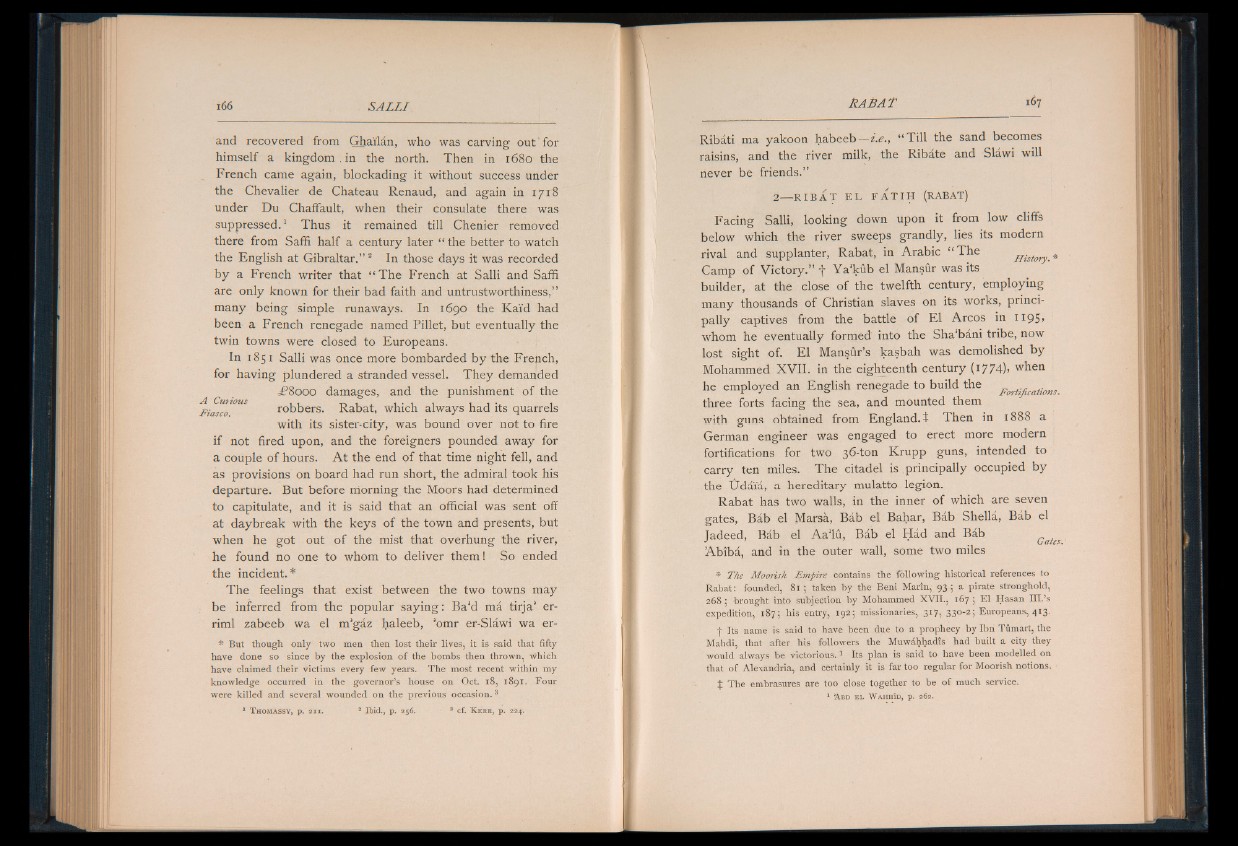
and recovered from Ghailan, who was carving out' for
himself a kingdom . in the north. Then in 1680 the
French came again, blockading it without success under
the Chevalier de Chateau Renaud, and again in 1718
under Du Chaffault, when their consulate there was
suppressed.1 Thus it remained till Chenier removed
there from Saffi half a century later “ the better to watch
the English at Gibraltar.” 2 In those days it was recorded
by a French writer that “ The French at Salli and Saffi
are only known for their bad faith and untrustworthiness,”
many being simple runaways. In 1690 the Kai'd had
been a French renegade named Pillet, but eventually the
twin towns were closed to Europeans.
In 1851 Salli was once more bombarded by the French,
for having plundered a stranded vessel. They demanded
¿f?8ooo damages, and the punishment of the
Fiasco robbers. Rabat, which always had its quarrels
with its sister-city, was bound over not to fire
if not fired upon, and the foreigners pounded away for
a couple of hours. A t the end of that time night fell, and
as provisions on board had run short, the admiral took his
departure. But before morning the Moors had determined
to capitulate, and it is said that an official was sent off
at daybreak with the keys of the town and presents, but
when he got out of the mist that overhung the river,
he found no one to whom to deliver them 1 So ended
the incident.*
The feelings that exist between the two towns may
be inferred from the popular say ing : Ba‘d ma tirja* er-
riml zabeeb wa el m’gaz haleeb, ‘omr er-Slawi wa er-
* But though only two men then lost their lives, it is said that fifty
have done so since by the explosion of the bombs then thrown, which
have claimed their victims every few years. The most recent within my
knowledge occurred in the governor’s house on Oct. 18, 1891. Four
were killed and several wounded on the previous occasion.3
1 T h o m a s s y , p . 211. 2 Ibid., p . 256. 3 cf. K e r r , p. 224.
Ribati ma yakoon habeeb—i.e., “ Till the sand becomes
raisins, and the river milk, the Ribate and Slawi will
never be friends.”
2— R I B A T E L F A T IH (RABAT)
Facing Salli, looking down upon it from low cliffs
below which the river sweeps grandly, lies its modern
rival and supplanter, Rabat, in Arabic “ The History.*
Camp of Victory.” f Y a ’kub el Mansur was its
builder, at the close of the twelfth century, employing
many thousands of Christian slaves on its works, principally
captives from the battle of El Arcos in H 9 S>
whom he eventually formed into the Sha’bani tribe, now
lost sight of. El Mansur’s kasbah was demolished by
Mohammed XVII. in the eighteenth century ( 1774)» when
he employed an English renegade to build the Fortifications.
three forts facing the sea, and mounted them
with guns obtained from England, t Then in 1888 a
German engineer was engaged to erect more modern
fortifications for two 36-ton Krupp guns, intended to
carry ten miles. The citadel is principally occupied by
the Udaia, a hereditary mulatto legion.
Rabat has two walls, in the inner of which are seven
gates, Bab el Marsa, Bab el Bahar, Bab Sheila, Bab el
Jadeed, Bab el A a ‘lu, Bab el Had and Bab
Abiba, and in the outer wall, some two miles
* The Moorish Empire contains the following historical references to
Rabat: founded, 81; taken by the Beni Marin, 93; a pirate stronghold,
268 5 brought into subjection by Mohammed XVII., 167 5 El Hasan IH.’s
expedition, 187; his entry, 192; missionaries, 317, 330-2; Europeans, 413.
f Its name is said to have been due to a prophecy by Ibn Tumart, the
Mahdi, that after his followers the Muwahhadis had built a city they
would always be victorious.1 Its plan is said to have been modelled on
that of Alexandria, and certainly it is far too regular for Moorish notions.
j; The embrasures are too close together to be of much service.
1 A b d e l W a h h id , p . 262.